Steamboat company officials, town and county officers of Martha’s Vineyard and Nantucket, together with numerous representative men from the Islands and the mainland, were guests of the New Bedford, Martha’s Vineyard and Nantucket Steamboat company aboard the new steamer Naushon which made her first trip over the Island run on Tuesday. Never dawned a finer day for such an event, nor did a new creation of the hand of man ever perform more satisfactorily, and the run from New Bedford with stops at Oak Bluffs and Woods Hole each way was a truly enjoyable event to every person aboard.
The Naushon reached Oak Bluffs at about 11:30 and a fair sprinkling of Island people was there to watch her approach. The first thing noticeable, as the Island’s largest ship hove in sight, was the total absence of any top heavy appearance which many had previously declared to be unavoidable because of the extra deck. Her very short smokestack also adds to her stable appearance. Captain Ralph M. Packer, veteran steamship captain, declared her to be an exact replica of the English Channel steamers, built to navigate in one of the roughest bodies of water on the face of the earth.
Docking Was Difficult
Docking at Oak Bluffs was difficult owing to the condition of the pier-head which is being repaired and enlarged, and as the piling was unsecured Captain Durfee did not care to risk putting any strain on it but worked his ship in with her screw alone.
At Oak Bluffs among the guests who boarded the Naushon were: John Billings and M. J. Keegan, selectmen and Herbert Eddy of Oak Bluffs; Charles S. Norton, director of the company and its Vineyard representative; Captain Ralph M. Packer, Francis X. Hurley, C. J. Darling, S. C. Luce Jr.; Harry B. Turner, publisher of the Nantucket Inquirer and Mirror; and Joseph C. Allen, Vineyard Gazette representative.
These were welcomed by the company which had come down from the city and which included J. Howland Gardner, president of the New England Steamship company; Frank J. Wall, assistant to the president; John Burgin, New York general assistant; William A. Smith, general agent of the line in New Bedford; A. H. Ferguson, transportation manager of the New Bedford Board of Commerce; Albert Haas, marine designer, who designed the Naushon; Mayor Charles S. Ashley of New Bedford; James L. Humphrey, H. S. Hutchinson, Captain George Fred Tilton; George A. Hough, managing editor of the New Bedford Standard; George S. Reynolds; and Representative Arthur Jones of Nantucket.
The stop was necessarily brief and once under way again the Naushon headed for Nantucket while the various Vineyard guests started on a tour of inspection and exploration which began at the steamer’s tremendous cavern-like cargo deck and progressed through her luxurious saloons and staterooms from deck to deck until the weather deck and the wheelhouse were reached.
There are four decks on the Naushon, two of which are devoted entirely to the accommodation of passengers, the saloon and the hurricane decks. The cargo deck has a saloon aft where passengers board, very large and comfortable, and the weather deck, topping everything, is to be barred to passengers.
Nantucket Gives Royal Welcome
The arrangement on the two passenger decks is novel in its convenience. There is a saloon at both forward and after ends, furnished with chairs and settees of wicker, well supplied with cushions. There is open deck space provided with chairs at wither end and there are staterooms on both decks, 32 in all, and also toilets and lavatories.
On the saloon deck there is a promenade entirely around the outside, the staterooms opening on the deck. On the hurricane deck there is no promenade and the ports open over the water, but all are outside rooms although not of the same size.
The smaller rooms are fitted with a type of day bed which is ordinarily arranged to form a sort of davenport but which can be opened to form a double bed.
These are well provided with mattresses, cushions and all necessary appurtenances. There are tables, chairs and wash bowls in these smaller rooms, all attractive but of simple design. Simplicity is the rule aboard the Naushon and there is no unattractive “gingerbread” work to conceal the beauty of the ship.
In the larger rooms there is, in addition to the other furnishings and some extra fittings, a number of toilets and lavatories in small, well arranged rooms accessible only from the stateroom itself.
Right amidship, on the saloon deck, is the lunchroom, equipped with a counter and stools and tables with regular chairs. Everything is complete even to the electric toasters where the Naushon’s chefs were kept busy on the trip, turning out toasted ham sandwiches. It was a hungry crowd, and the food was excellent and provided in plenteous quantities, for although there was a continuous stream of hungry men storming the lunchroom, no article of food was exhausted. Salads, sandwiches, coffee and dessert dishes were the principal articles consumed and there were many cigars and cigarettes being passed over the counter, all provided for the guests.
Passenger Decks Well Arranged
As soon as the Naushon had approached near enough to Nantucket for her passengers to see people on the beach, that island appeared to declare a holiday. Whistles had blown at every place where there was one, and the Cross Rip lightship had saluted in the approved style, but at Nantucket flags were dipped, bells rung, and from every boat, the power house, cold storage plant and other sources that could not be discovered, whistles of every key blared out a greeting to the new steamer.
The gates at the head of the wharf were closed, a wise provision, for the schools were all dismissed and flocks of the children were pressing against the gates with plenty of grown-ups mingled with them. Inside the enclosure were a number of cars, parked in anticipation of giving the visitors a ride about the Island, which many were pleased to accept.
Here many of these men from the mainland and the Vineyard saw for the first time in many years horses and surreys, not old, dilapidated rigs, but the shining, canopy-topped equipages of other days with sleek, well groomed horses. Here, too, they saw livery stables, going concerns with many carriages of all kinds in front or on the floor.
The cars traveled through the principal streets of Nantucket, passing several of the points of interest which the drivers were glad to explain, and the town proper was fairly well looked over before it was time to go aboard again.
As the steamer left the dock, the children were allowed on the wharf, after having inspected the boat, and the passengers threw coins of various denominations to them, watching the tumult as the boys scrambled for them.
With continued fair weather and smooth seas the Naushon headed for the Vineyard, reaching Oak Bluffs in exactly two hours from the time of leaving.
The Naushon is the boat that is expected to carry most of the cars to and from the Vineyard this season as she will be scheduled to make two landings each day. William A. Smith, general agent, said that the company is planning to handle all freight and passenger traffic with the four big boats, but nevertheless, if it becomes necessary, the Uncatena is available and can be put on the run.
That plenty of business be found for the new boat is considered most important, and hence the schedule allows trips to Nantucket and the Vineyard with long stop-overs on the same day. The Naushon is ideal for the purpose. Her size, greater in beam and length than any of the other boats, gives her the greatest passenger carrying capacity despite the greater cargo space, and her accommodations are admirable suited for excursion purposes, as there is absolutely no danger of a crowd being caught on a deck unprotected from the weather.
Further Improvements Forecast
While an increase in business is now sought, Mr. Smith did not scoff at the idea that further boats may be built in the not too distant future, nor did he discourage the suggestion that it may be possible to make a change in the rates of automobiles. But first of all, he implied that the new schedule would have to be tried out thoroughly. If it is successful, then consideration can be given to suggestions for further improvements in the service.
Both Mr. Smith and Mr. Wall, although making few definite statements, gave the impression that the new boat and the improved service are only the beginning of a program of development in the Island’s transportation system. And the impression is clear that, having made a new step ahead, the company is only pausing before following it with others.
The captain of the Naushon is new to the Island line, although he has been in command of the Pequot on some of her ferrying trips between Woods Hole and the Vineyard. He is Captain Lawrence Durfee who has had long experience on the Fall River Line. Captain Durfee’s home is in New Bedford.
There are two pilots, both from the Long Island Sound lines of the New England Steamship Company. Webster Gifford is one, and George Backus, the other, has had service on the Island run. Carrol Schroeder moves over from the New Bedford to become chief engineer of the Naushon. The mates on the new steamer are Malcolm Salmonson, 1st, and William Mickolaick, 2nd, both of them from the N. B., M. V. & N. Steamboat Co. personnel. The purser is Harold Fradpietro, previously on the Island line boats.
The Naushon carries a crew of 58, 10 more than the other boats. Heretofore the steamers have carried from 43 to 44 men but all the crews have been stepped up in anticipation of the new schedule. All steamers will carry two pilots with the beginning of the summer schedule Sunday.


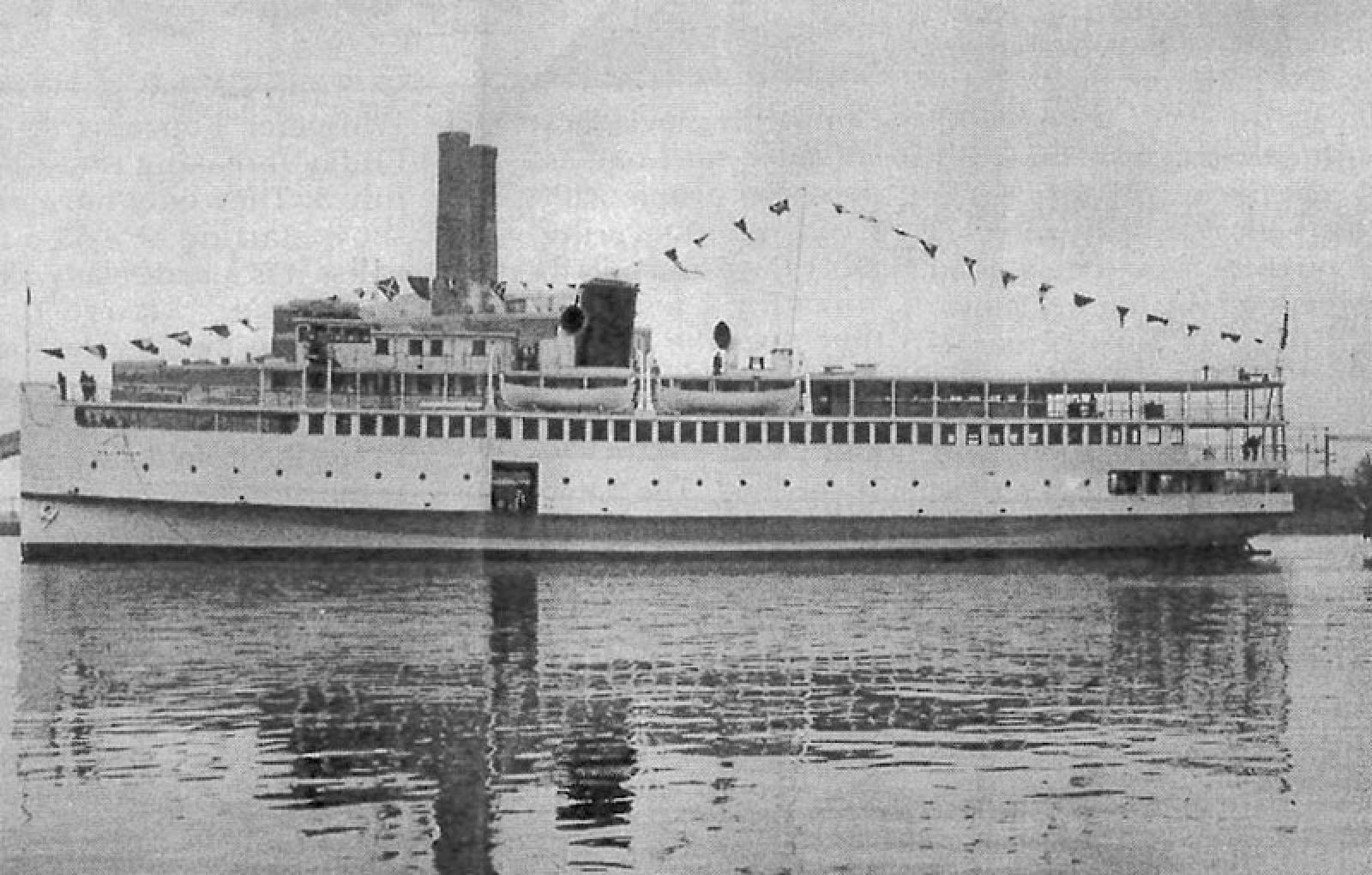



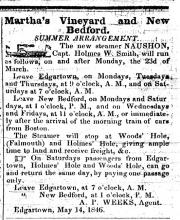

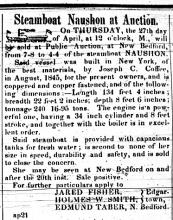
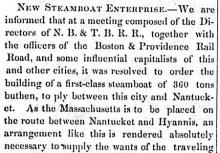
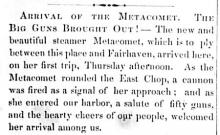
Comments